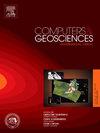Edge-guided segmentation of digital rock images: Integrating a pretrained edge aware path with the main segmentation path
IF 4.2
2区 地球科学
Q1 COMPUTER SCIENCE, INTERDISCIPLINARY APPLICATIONS
引用次数: 0
Abstract
Accurate segmentation of digital rock images is pivotal in digital rock analysis, as it significantly influences the outcomes of subsequent numerical simulations and parameter calculations. Traditional deep learning models for semantic segmentation often require extensive datasets for effective training, but acquiring rock samples used to be costly, hindering dataset expansion. Typical single-path segmentation models primarily focus on extracting semantic features, which may limit segmentation accuracy, especially for fine-grained segmentation of minor features. Incorporating edge feature information relevant to matrix and pore segmentation can improve segmentation accuracy while optimizing limited data resources. Therefore, a dual-path deep learning segmentation model introducing an additional edge-aware pathway to improve segmentation accuracy, because the edge features obtained from the edge-aware pathway are not only utilized as prior information alongside the original image to guide more effective feature extraction but also integrated into the decoding module to offer boundary constraint support for the image information restoration process. As an example of SegNet, the improved SegNet has shown improvements of 9.58%, 16.44%, 10.98%, and 7.57% in Dice, IoU, Precision, and Recall metrics, respectively, and the relative errors of elastic properties in terms of bulk modulus, shear modulus, and P- and S- wave velocities decrease by 7.06%, 12.13%, 4.22%, and 6.71%, respectively, and its performance better than the powerful DeepLabv3+ model. The similar improvement is observed in ResSegNet, UNet and ResUNet as introducing edge information, which demonstrates excellent performance on small datasets and lower computational costs and dataset requirements.
数字岩石图像的边缘引导分割:将预训练的边缘感知路径与主分割路径相结合
数字岩石图像的准确分割是数字岩石分析的关键,因为它对随后的数值模拟和参数计算结果有重要影响。用于语义分割的传统深度学习模型通常需要大量的数据集才能进行有效的训练,但获取岩石样本的成本很高,阻碍了数据集的扩展。典型的单路径分割模型主要关注语义特征的提取,这可能会限制分割的准确性,特别是对次要特征的细粒度分割。结合与矩阵和孔隙分割相关的边缘特征信息,可以在优化有限数据资源的同时提高分割精度。因此,双路径深度学习分割模型引入额外的边缘感知路径来提高分割精度,因为从边缘感知路径获得的边缘特征不仅与原始图像一起作为先验信息来指导更有效的特征提取,而且还集成到解码模块中,为图像信息恢复过程提供边界约束支持。以SegNet为例,改进后的SegNet在Dice、IoU、Precision和Recall指标上分别提高了9.58%、16.44%、10.98%和7.57%,在体积模量、剪切模量和P波和S波速度方面的弹性特性相对误差分别降低了7.06%、12.13%、4.22%和6.71%,性能优于功能强大的DeepLabv3+模型。在ResSegNet, UNet和ResUNet中,通过引入边缘信息可以观察到类似的改进,这在小数据集上表现出优异的性能,并且降低了计算成本和数据集需求。
本文章由计算机程序翻译,如有差异,请以英文原文为准。
求助全文
约1分钟内获得全文
求助全文
来源期刊

Computers & Geosciences
地学-地球科学综合
CiteScore
9.30
自引率
6.80%
发文量
164
审稿时长
3.4 months
期刊介绍:
Computers & Geosciences publishes high impact, original research at the interface between Computer Sciences and Geosciences. Publications should apply modern computer science paradigms, whether computational or informatics-based, to address problems in the geosciences.
 求助内容:
求助内容: 应助结果提醒方式:
应助结果提醒方式:


